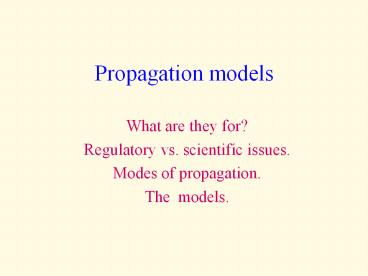Propagation models - PowerPoint PPT Presentation
Title:
Propagation models
Description:
Terrain features, and buildings, usually attenuate signals. ... The OKUMURA-HATA model calculates attenuation taking account of the percentage ... – PowerPoint PPT presentation
Number of Views:1056
Avg rating:3.0/5.0
Title: Propagation models
1
Propagation models
- What are they for?
- Regulatory vs. scientific issues.
- Modes of propagation.
- The models.
2
ITU Recommendations on Radiowave Propagation
3
Modes of propagation propagation loss
- Free space
- Ground wave. Diffraction around a smooth earth.
Ground reflections. Effect of terrain. - Ionospheric, including sporadic E
- Tropospheric refraction, super-refraction and
ducting, forward scattering - Diffraction over knife edge rounded edge
- Atmospheric attenuation
- Variability Statistics
4
Free space propagation
- EIRP (watts) to pfd (w/m2) P/(4.pi.D2)
- equivalent to (dBW 11 -20.log(D))
- EIRP (watts) to E (V/m) sqrt(30.P)/D
- EIRP (kW) to E (V/m) 173sqrt(P)/Dkm
- Also pfd (W/m2)E2/Z0E2/(120.pi)
5
Free space loss
- Note that EIRP(W) to pfd(W/m2) is frequency
independent - EIRP(W) to Prx(W) in isotropic antenna is
PrxPeirp/(4.pi.D2)lambda2/(4.pi)
I.e. isotropic
to isotropic antenna free-space loss increases as
frequency squared.
6
Ground wave propagation
- Most relevant for low frequencies (lt30 MHz)
- Depends on ground constants (conductivity,
permittivity) - Various ITU recommendations ITU-R P.368 etc.
Program GRWAVE available from ITU web pages
7
(No Transcript)
8
Ionospheric propagation
- Most relevant up to about 30 MHz
- Many modes of propagation a complicated topic.
- Sporadic E can be important up to about 70 MHz.
(ITU-R P.534) - Highly variable
9
Tropospheric
- Variations of radio refractive index
- Normal change with height causes greater than
line-of-sight range. Often taken into account by
assuming increased radius for the earth e.g.
(4/3) - Temperature inversions can cause ducting, with
relatively low attenuation over large distances
beyond the horizon - Small scale irregularities are responsible for
forward scatter propagation. - Rain scatter can sometimes be a dominant mode.
10
(No Transcript)
11
Obstacles
- Terrain features, and buildings, usually
attenuate signals. (NB in some circumstances
knife edge diffraction can enhance propagation
beyond the horizon) - The OKUMURA-HATA model calculates attenuation
taking account of the percentage of buildings in
the path, as well as natural terrain features.
12
(No Transcript)
13
Is an Obstruction Obstructing?
14
(No Transcript)
15
(Radio Horizon)
16
Knife Edge diffraction
17
(No Transcript)
18
Atmospheric attenuation
- Starts becoming relevant above about 5 GHz
- Depends primarily, but not exclusively on water
vapour content of the atmosphere - Varies according to location, altitude, path
elevation angle etc. - Can add to system noise as well as attenuating
desired signal - Precipatation has a significant effect
19
(No Transcript)
20
Propagation models
- The ITU recommendations give many approved
methods and models - Two popular methods are are the
- Okumura-Hata
- and the
- Longley Rice
21
(No Transcript)
22
(No Transcript)
23
(No Transcript)
24
Longley-Rice model TRANSMISSION LOSS PREDICTIONS
FOR TROPOSPHERIC COMMUNICATION CIRCUITS
- Longley Rice has been adopted as a standard by
the FCC - Many software implementations are available
commercially - Includes most of the relevant propagation modes
multiple knife rounded edge diffraction,
atmospheric attenuation, tropospheric propagation
modes (forward scatter etc.), precipitation,
diffraction over irregular terrain, polarization,
specific terrain data, atmospheric
stratification, different climatic regions, etc.
etc.
25
(No Transcript)
26
(No Transcript)
27
NRAO TAP model (SoftWright implementation with
the Terrain Analysis Package
Notes on The Prediction of Tropospheric Radio
Transmission Loss Over Irregular Terrain (the
Longley-Rice Model) propagation in the Terrain
Analysis Package (TAP). The Longley-Rice model
predicts long-term median transmission loss over
irregular terrain relative to free-space
transmission loss. The model was designed for
frequencies between 20 MHz and 40 GHz and for
path lengths between 1 km and 2000 km. ... This
implementation is based on Version 1.2.2 of the
model, dated September 1984. Note also that the
version 1.2.2 implemented by SoftWright does not
utilize several other corrections to the model
proposed since the method was first published
(see A. G. Longley, "Radio propagation in urban
areas," OT Rep. 78-144, Apr. 1978 and A. G.
Longley, "Local variability of transmission loss-
land mobile and broadcast systems," OT Rep., May
1976). Technical Foundation ...
28
Problems with models
- All models have limitations e.g. Longley Rice
doesnt include ionosphere, so limited
applicability at lower frequencies. Some skill is
needed in choosing the right model for the right
circumstances. - Accuracy is limited. Different models can give
different answers. - May need a statistical interpretation
- Need good input data (e.g. terrain models)
- Any model needs fairly universal acceptance, to
avoid legal arguments. Acceptance may be more
important than accuracy. - What is the height of a radio telescope?
29
Where does this leave us?
- In spite of the difficulties, propagation models
have come a long way. - We cant live without them.
- The best guide we have to whether a given
terrestrial transmission will cause interference
to a radio telescope. - The best guide we have as to whether a given size
of coordination zone will be adequate.































